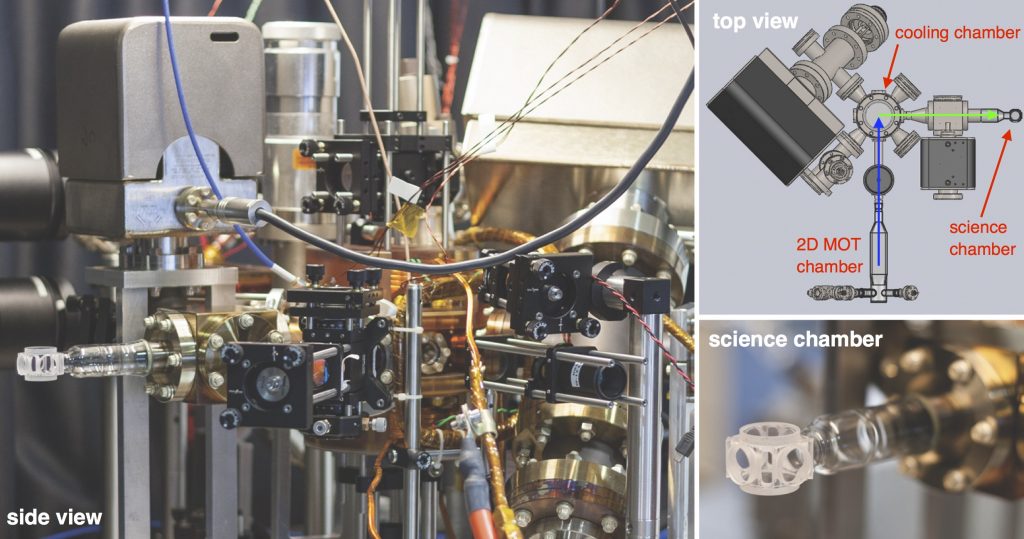The heart of the apparatus is a vacuum system composed of three interconnected chambers (see figure below). In the first chamber, 40K is dispensed from home-built sources. Then, a 2D Magneto-Optical Trap (MOT) generates a stream of cold atoms that fly through a narrow nozzle to the second chamber. The nozzle enables us to maintain different vacuum conditions in the first and second chambers, optimized to achieve the best performance of the 2D-MOT and long lifetime of trapped atoms (around 80 seconds) in the second chamber. This long lifetime is important for the efficiency of evaporation in the following stage.
In the second chamber we perform most of the cooling stages. We start by loading a 3D MOT with a dark spot. The dark spot is necessary to mitigate density dependent loss which is substantial in 40K and which would otherwise limit the attainable numbers at the end of MOT loading. We end with around 109 atoms at around 200 μK. The next cooling stage is optical grey molasses on the D1 transition, which cools the atoms to around 20 μK, and is followed by optical pumping predominantly to the states |f=9/2,mf=9/2> and |f=9/2,mf=7/2>, and loading to a magnetic trap in a QUIC configuration. Immediately after switching on the magnetic trap, we find 5 x 108 atoms at around 170 μK. Next, we perform forced microwave evaporation, which we usually stop at a frequency corresponding to around 8 μK, and we have typically 30M atoms. These conditions correspond to T/TF ≈3.5 and are favourable for loading an optical trap. With further RF evaporation, however, we can also reach T/TF<1, but magnetic evaporation becomes less efficient.
After evaporation in the magnetic trap has ended, we switch on a far-off-resonance optical trap at 1064nm. The trap is made of a single Gaussian beam with a waist of 30 μm and a power of 4W. We get around 15M atoms at around T/TF ≈2.5. Next, the atoms are moved a distance of 328 mm in a little more than 2sec, from the cooling to the science chamber. This is done by moving the lens creating the optical trap outside of the chamber, using an air-bearing translation stage to avoid heating. After the transfer is done, we switch on a second optical trap at an angle of 450 with the first beam, and generate a crossed trap at the center of the science chamber. Finally, we perform evaporation in the crossed optical trap by lowering the intensity of the lasers.
The science chamber is designed as a mini asymmetric glass octagon with all windows anti-reflection coated on both facets (see figure below). If the atoms are held in the center of the chamber, the numerical aperture (NA) from above and below is 0.75, and 0.5 from the sides. The atoms can also be brought closer to one of the large windows, and the NA can in principle be increased to around 0.9. Around the science chamber we have designed and built an assembly of coils including Helmholtz coils for the Feshbach field, and a smaller coil for fast sweeping, a gradient coil for Stern–Gerlach splitting of different spins, and RF and MW antennas. We have also built an electrical circuit which can run hundreds of Ampers in the Feshbach coils (and in the QUIC trap, which is around the cooling chamber) with a stability of several parts per million.
Currently, we are optimizing the optical transfer and optical evaporation in the science chamber. We can reach T/TF∼0.15-0.2 with around 100,000 per spin state.


